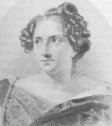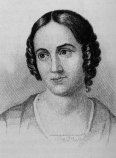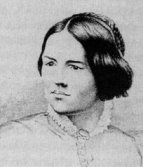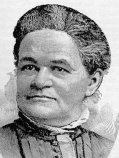| Definitions |
Sometimes referred to as "sentimental fiction"
or "woman's fiction," "domestic fiction" refers to a type of novel
popular with women readers during the middle of the nineteenth century.
The genre began with Catharine Sedgwick's New-England Tale (1822)
and remained a dominant fictional type until after 1870. It derives
in part from the eighteenth-century "sentimental
novel" or "novel of sensibility," of which Henry Mackenzie's The
Man of Feeling (1771), Oliver Goldsmith's The Vicar of Wakefield
(1766), and one of the earliest American novels, The Power of Sympathy
(1789), written by William Hill Brown but ascribed circa 1860 to Sarah
Wentworth Morton (Feminist Companion to Literature in English 766),
are examples. In their reliance on the inherent goodness of human nature
and the power of feelings as a guide to right conduct, these novels were
in part a reaction against Calvinistic doctrines that viewed humanity as
inherently depraved.
According to Nina Baym, who describes the genre
in Woman's Fiction, the basic plot of woman's fiction involves "the
story of a young girl who is deprived of the supports she had rightly or
wrongly depended on to sustain her throughout life and is faced with the
necessity of winning her own way in the world . . . . At the outset she
takes herself very lightly--has no ego, or a damaged one, and looks to
the world to coddle and protect her . . . .To some extent her expectations
are reasonable--she thinks that her guardians will nurture her . . . But
the failure of the world to satisfy either reasonable or unreasonable expectations
awakens the heroine to inner possibilities. By the novel's end she has
developed a strong conviction of her own worth as a result of which she
does ask much of herself. She can meet her own demands, and, inevitably,
the change in herself has changed the world's attitude toward her, so much
that was formerly denied her now comes unsought" (Baym 19). |
| . |
 Baym
suggests that the story "exists in two parallel versions. In one, the heroine
begins as a poor and friendless child. Most frequently an orphan, she sometimes
only thinks herself to be one, or has by necessity been separated from
her parents for an indefinite time. In the second, the heroine is a pampered
heiress who becomes poor and friendless in midadolescence, through the
death or financial failure of her legal protectors" (35). Baym
suggests that the story "exists in two parallel versions. In one, the heroine
begins as a poor and friendless child. Most frequently an orphan, she sometimes
only thinks herself to be one, or has by necessity been separated from
her parents for an indefinite time. In the second, the heroine is a pampered
heiress who becomes poor and friendless in midadolescence, through the
death or financial failure of her legal protectors" (35).
Susan K. Harris has called this "the dominant
novelist subgenre of the 1850s and 1860s, the type that Brown called 'sentimental,'
Baym 'women's, and Kelley 'domestic.'" |
| Characteristics |
1. Plot focuses on a heroine who embodies one
of two types of exemplar: the angel and the practical woman (Reynolds)
who sometimes exist in the same work. Baym says that this heroine is contrasted
with the passive woman (incompetent, cowardly, ignorant; often the heroine's
mother is this type) and the "belle," who suffers from a defective education.
2. The heroine struggles for self-mastery, learning
the pain of conquering her own passions (Tompkins, Sensational Designs,
172)
3. The heroine learns to balance society's demands
for self-denial with her own desire for autonomy, a struggle often addressed
in terms of religion.
4. She suffers at the hands of abusers of power
before establishing a network of surrogate kin.
5. The plots "repeatedly identify immersion in
feeling as one of the great temptations and dangers for a developing woman.
They show that feeling must be controlled. . . " (Baym 25). Frances Cogan
notes that the heroines thus undergo a full education within which to realize
feminine obligations (The All-American Girl).
6. The tales generally end with marriage, usually
one of two possible kinds:
1. Reforming the bad or "wild" male, as in Augusta
Evans's St. Elmo (1867)
2. Marrying the solid male who already meets
her qualifications.
Examples: Maria Cummins, The Lamplighter
(1854)
Susan Warner, The Wide, Wide World (1850)
7. The novels may use a "language of tears" that
evokes sympathy from the readers.
8. Richard Brodhead (Cultures of Letters) sees
class as an important issue, as the ideal family or heroine is poised between
a lower-class family exemplifying poverty and domestic disorganization
and upper-class characters exemplifying an idle, frivolous existence (94). |
| Practitioners |
(largely adapted from Baym, Woman's Fiction;
not all the books listed below fit Baym's definition)
| Catharine
Maria Sedgwick (1789-1867) |
Caroline Lee (Whiting) Hentz (1800-1856) |

(Image courtesy of the Legacy
site.)
A
New-England Tale (1822)
Redwood (1824)
Hope Leslie; or, Early Times in Massachusetts
(1827; historical romance)
Clarence: or, A Tale of Our Times (1830)
The Linwoods: or, Sixty Years Since in America
(1835; historical romance)
Didactic Tales: Home: Scenes and Charactors
Illustrating Christian Truth (1835)
Live and Let Live: or, Domestic Service
(1837)
Tales and Sketches, Second Series (1844)
Married or Single? (1857)
The Linwoods
|

(Image courtesy of the Legacy
site.)
Linda (1850)
Rena, the Snowbird (1850)
Eoline (1852)
Marcus Warland (1852)
Helen and Arthur (1853)
The
Planter's Northern Bride (1854)
Robert Graham (1855; sequel to Linda)
Ernest Linwood (1856) |
| Maria Jane McIntosh (1803-1878) |
Susan Bogert Warner (1819-1885) (pseudonym:
Elizabeth Wetherell) |
"Aunt Kitty's Tales" (juvenile fiction; 1841-1843)
Woman an Enigma (her first woman's fiction;
pub. anonymously in 1843)
Two Lives (1846)
Charms and Counter-Charms (1848)
Violet; or The Cross and the Crown (1856)
Two Pictures; or What We Think of Ourselves
and What the World Thinks of Us (1863) |
 The
Wide, Wide World (1850)
The
Wide, Wide World (1850)
Queechy (1852)
The Hills of the Shatemuc (1856; said
to have sold 10,000 copies on the first day of publication [Baym 156]) |
| E. D. E. N. Southworth (1819-1899) |
Ann Sophia Winterbotham Stephens (1810-1886) |
-
Self-Made (serialized 1863, 1864; published
as Ishmael and Self-Raised, 1876)
-
Shannondale (serialized 1850; published in
book form, 1851)
-
The Discarded Daughter (serialized 1851, 1852;
published 1852)
-
The Curse of Clifton (serialized 1852; published
1853; her most popular book until The Hidden Hand)
-
India (The Pearl of Pearl Island) (serialized
as Mark Sutherland, 1853; published 1855)
-
The Lost Heiress (serialized 1853; published
1854)
-
Miriam the Avenger (The Missing Bride,
The Fatal Vow) (serialized 1854; published 1855)
-
Vivia, or the Secret of Power (serialized
1856; published 1857)
- The Missing Bride
- The Lost Lady of Lone
- Ishmael, or In the Depths
-
The
Hidden Hand (serialized 1859; published in book form 1889)
- Capitola, the Madcap: Part II of The Hidden Hand
- For Woman's Love (1890)
-
Sybil
Brotherton, or The Temptation
|
 (Image courtesy of the Legacy
site)
(Image courtesy of the Legacy
site)
-
Mary Derwent (Ladies' Companion,
May-October 1838; romance of Indians and pioneers)
-
Fashion and Famine (1854)
-
The Old Homestead (1855;
her most popular novel)
Malaeska (early novella reprinted as the
first dime novel in Beadle's library, 1860)
|
| Maria Susanna Cummins (1827-1866) |
Caroline Chesebro' (1825-1873) |
The Lamplighter (1854; published
anonymously; sold 40,000 copies in 2 months)
Mabel Vaughan (1857) |
Isa, a Pilgrimage (1852)
The Children of Light (1853)
Getting Along: A Book of Illustrations (Susan,
the Fisherman's Daughter; or, Getting Along) (1855)
Victoria, or The World Overcome (1856;
historical novel on witchcraft)
Philly and Kit (1856)
Peter Carradine (1863) |
| Mary Jane Holmes (1825-1907) |
Mary Virginia Hawes (Terhune)(1830-1922) (pseudonym:
Marian Harland) |
Tempest and Sunshine (1854)
The English Orphans (1855)
Lena Rivers (1856)
Meadow-brook (1857)
Dora Deane; or, the East India Uncle (1859)
The Leighton Homestead
Maggie Miller
Marian Grey (1863)
Mildred
Rosamond, or the Youthful Error
The Rector of St. Mark's
Millbank, or, Roger Irving's Ward
Darkness and Daylight: A Novel
Aikenside
Cousin
Maude |
 (Image courtesy of the Legacy
site.)
(Image courtesy of the Legacy
site.)
Alone (1854)
At Last
The Hidden Path (1855)
Moss-Side (1857)
Nonfiction: Common
Sense in the Household; A Manual of Practical Housewifery (1870)
Marion
Harland's Autobiography: The Story of a Long Life (1910) |
Henry Louis Gates identifies Harriet Wilson's
Our Nig (1859) as containing elements of the domestic plot.
Baym says that Harriet
Beecher Stowe should not be included "because the good women are
not engaged in their own cause, either as individuals or in the interest
of their sex, but in a cause where their own welfare is not directly involved
or may even be endangered. When juxtaposed with woman's fiction,
we see Stowe's work as pursuing a course that sometimes appears to go against
the secular and self-fulfilling current of the popular genre, especially
in its emphasis on self-sacrifice" (233) |
Context
and
Controversy |
In "Sentimental Power: Uncle Tom's Cabin and
the Politics of Literary History" (in Sensational Designs: The Cultural
Work of American Fiction, 1790-1860 [New York: Oxford U P, 1985]),
Jane Tompkins argues for the significance of this form of fiction. Tompkins
characterizes the views of such critics as Perry Miller, F. O. Matthiessen,
Richard Chase, Harry Levin, R.W.B. Lewis as follows:
Twentieth-century critics have taught generations
of students to equate popularity with debasement, emotionality with ineffectiveness,
religiosity with fakery, domesticity with triviality, and all of these,
implicitly, with womanly inferiority. In this view, sentimental novels
written by women in the nineteenth century were responsible for a series
of cultural evils whose effects still plague us: the degeneration of American
religion from theological rigor to anti-intellectual consumerism, the rationalization
of an unjust economic order, the propagation of the debased images of modern
mass culture, and the encouragement of self-indulgence and narcissism in
literature's most avid readers--women . . . . In contrast to male authors
like Thoreau, Whitman, and Melville, who are celebrated as models of intellectual
daring and honesty, these women are generally thought to have traded in
false stereotypes, dishing out weak-minded pap to nourish the prejudices
of an ill-educated and underemployed female readership. (82-83)
Tompkins opposes this view, arguing that "the popular
domestic novel of the nineteenth century represents a monumental effort
to reorganize culture from the woman's point of view; that this body of
work is remarkable for its intellectual complexity, ambition, and resourcefulness;
and that, in certain cases, it offers a critique of American society far
more devastating than any delivered by better-known critics such as Hawthorne
and Melville" (83). |
| Related
Sites |
Women's
Work in the Long Nineteenth Century. A course site that includes illustrations
from periodicals of the era.
African American
Women Writers of the Nineteenth Century. Online texts from the Schomburg
Collection.
Godey's Lady's Book.
Important 19th-century periodical.
Wright American Fiction
Collection. This is an online collection of 2,341 works published from
1851-1875.
Legacy. This journal
focuses on the study of American women writers, and its site contains pictures,
bibliographies, biographical sketches, and an index to the journal. The
pictures on this page are courtesy of this site.
Women's Dime Novels in 19th-century
America. This dissertation site includes information on Laura Jean
Libbey and other popular authors.
For other sites, go to the American
Literature Sites page
|
|
© 1997-2017. Donna M. Campbell. Some information adapted from Resisting Regionalism: Gender and Naturalism in American Fiction, 1885-1915 (Athens: Ohio University Press, 1997).
To cite this page on a Works Cited page according to current MLA guidelines, supply the correct dates and use the suggested format below. If you are quoting another author quoted on this page, either look up the original source or indicate that original quotation is cited on ("Qtd. in") this page. The following is drawn from the examples and guidelines in the MLA Handbook for Writers of Research Papers, 7th ed. (2009), section 5.6.2.
Campbell, Donna M. "Domestic or Sentimental Fiction, 1820-1865." Literary Movements. Dept. of English, Washington State University. Date of publication or most recent update (listed above as the "last modified" date; you don't need to indicate the time). Web. Date you accessed the page.
About this site
|
![]()